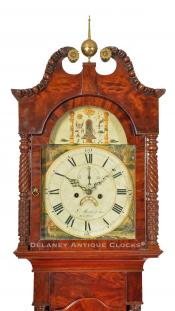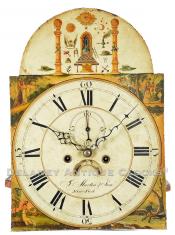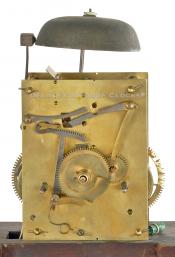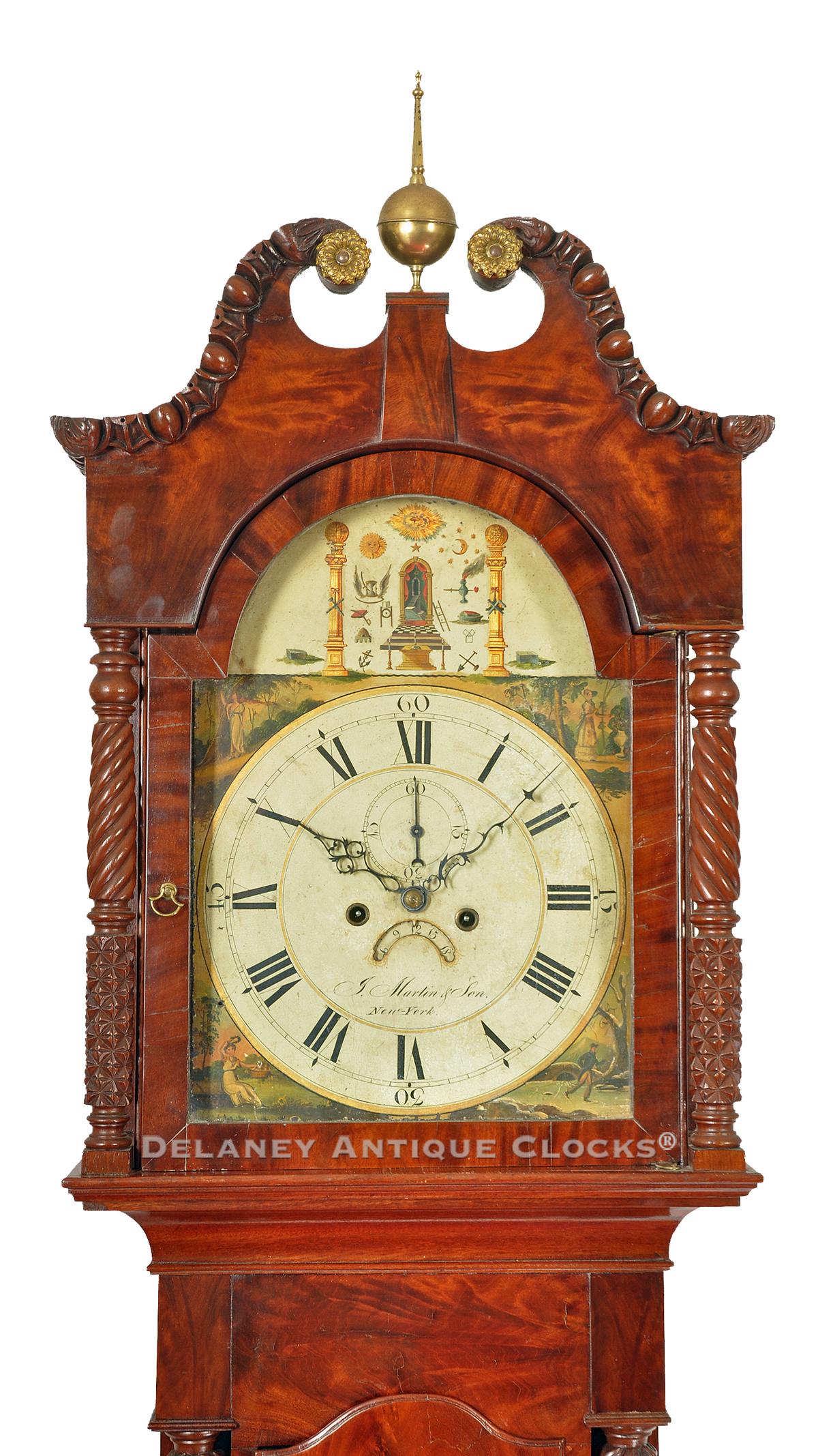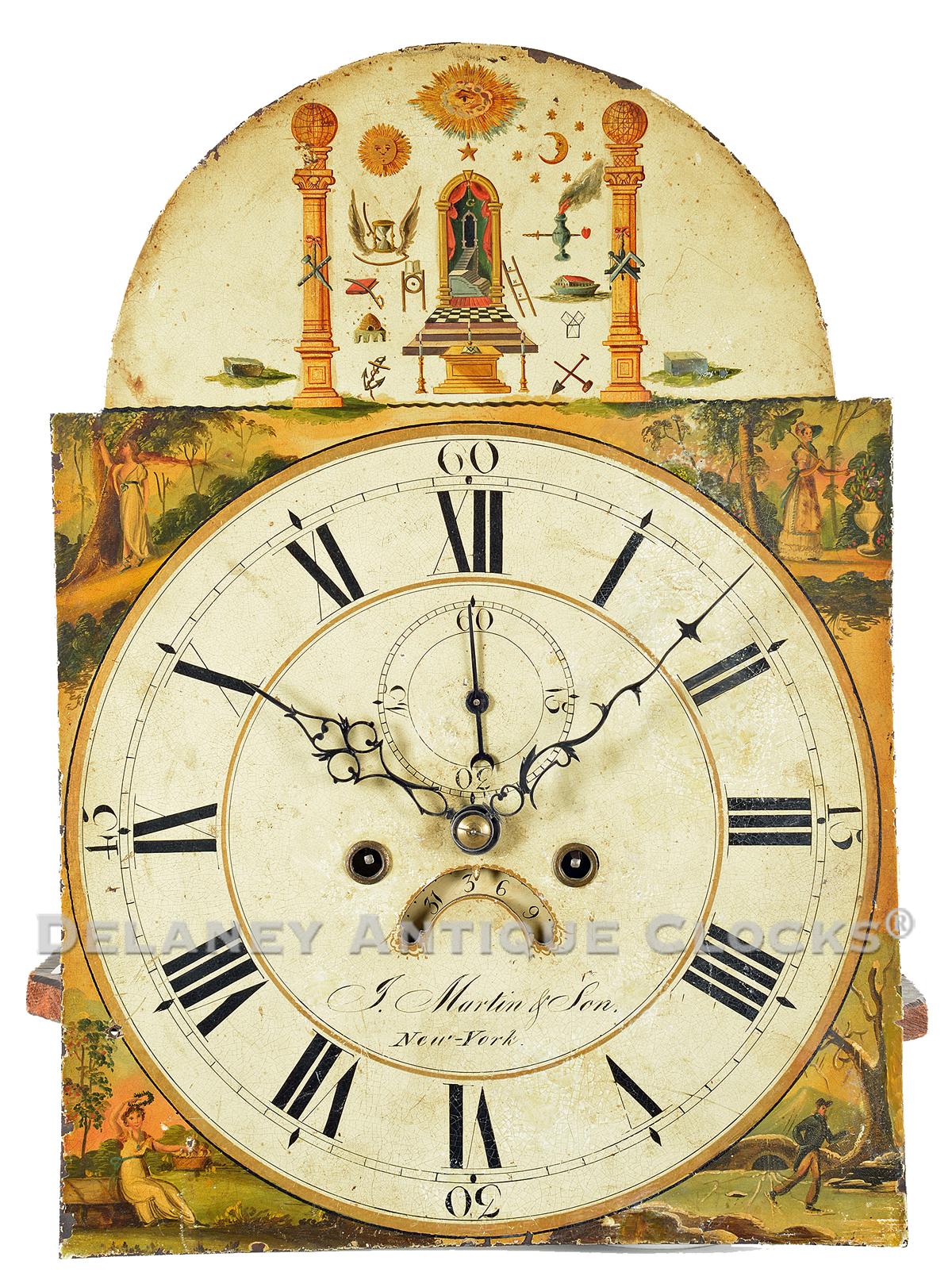J. Martin & Son of New York, New York. A masonic-themed dial. Tall clock. SS-160.
This is a beautifully figured mahogany case tall clock. This classical design is seldom seen in the tall case form. The intricate case design is typical of some of the finest Metropolitan furniture forms of the period. Exceptional woods were used in the layout and the construction of this case. This level of quality and craftsmanship commands your attention.
This case stands up off the floor on carved paw feet. They are wonderfully executed and feature a bold muscular form. Interestingly, we have owned at least three other clocks that share this similar carved foot design. The base panel features a mahogany cross-banded border. This frames a large crotch veneered center panel. The waist section is long and accentuates the case proportions. It features a nicely shaped door, an applied Irish panel, and richly veneered mounting blocks for the fully turned and skillfully carved waist columns. The waist door also features a superior example of crotch mahogany veneer. This door is trimmed with a simple molded edge and open to access the interior of the case. The bonnet or hood features a swan's neck pediment, which is an interesting variation of the form. The arch moldings are carved in an egg and dart design. The horns terminate with applied brass rosettes. A single brass ball and spike finial is centered between the swan's necks. It is supported by a plinth that is capped at the top. The arched pediment is supported by fully turned and carved bonnet columns. These are positioned on either side of the arched bonnet door. This door is glazed and opens to access a colorfully painted dial that the Clockmaker signed.
This colorfully painted dial is iron and measures 12 inches across. It is attached to the movement with a false plate. The four spandrels areas are fully developed. They each feature a depiction of one of the four seasons. In the lower-left corner is a young rosy-cheeked lady. She is holding a ring or garland in one hand and a basket of flowers in the other. Here, she represents spring. In the upper left is the same young lady standing in the shade of a fruit tree. Here she portrays the summer season. In the upper right corner of the dial, she is depicted wearing a bonnet and carrying a parasol over her right shoulder. Here she would represent the fall. In the lower right, the woman is replaced with a young man. He is smartly dressed and is skating across a river that has frozen enough to support his weight. This scene represents winter. The time ring is formatted with Roman hour numerals. Arabic figures are used to mark each of the quarter hours. A calendar aperture and a subsidiary seconds dial are located within the time ring. This dial is also signed by the Clockmaker in this center section. It reads in script lettering, "J. Martin & Son." Positioned below the signature is the working location of "NEW YORK." In the arch of this dial are a variety of colorful masonic symbols. Some of these include the Masonic Eye, the Masonic Alter, the Masonic Blazing Star, the Moon, the Bee and Beehive, the Masonic Pavement, the Masonic Ladder, the Two Pillars of Jachin and Boaz, the Terrestrial and Celestial Globes, the 46th Problem of Euclid, the Square and Compass, the Rough and Perfect Ashlar, the Ark, the Anchor, Etc.
The weight-driven movement is constructed in brass and is of good quality. Four turned pillars support the two brass plates. Hardened steel shafts support the polished steel pinions and brass gearing. The winding drums are grooved. The escapement is designed as a recoil format. The movement is weight driven and designed to run for eight days on a full wind. It is a two-train or a time and strike design having a rack and snail striking system. As a result, it will strike each hour on the hour. This is done on a cast iron bell which is mounted above the movement.
This clock was made circa 1825 stands 7 feet 11 inches tall to the top of the center finial. The case is 21 inches wide and 10.5 inches deep.
Inventory number SS-160.
Joseph Martin and John Martin of New York are both listed in several horological references. In truth, little is currently known about them. Joseph is listed as working in New York in 1811-1814. He is also listed in NYC directory as a watchmaker in 1827 working at 383 Greenwich. John is listed as being at work in New York in 1831. His working location is is listed as 184 and 288 Spring Street. A watch paper and a wall timepiece signed by them are reported.


